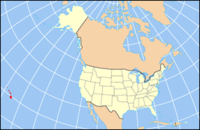Kalaupapa Peninsula
| Kalawao County, Hawaii | |
|---|---|
 Location in the U.S. state of Hawaii |
|
 Hawaii's location in the U.S. |
|
| Founded | 1905 |
| Seat | none (administered by Hawaii Dept. of Health) |
| Largest community | Kalaupapa |
| Area | |
| • Total | 53 sq mi (137 km2) |
| • Land | 12 sq mi (31 km2) |
| • Water | 41 sq mi (106 km2), 77.3% |
| Population (est.) | |
| • (2015) | 89 |
| • Density | 7.5/sq mi (3/km²) |
| Congressional district | 2nd |
| Time zone | Hawaii-Aleutian: UTC-10 |
Kalawao County is a county located in the U.S. state of Hawaii. The county encompasses the Kalaupapa or Makanalua Peninsula, on the north coast of the island of Molokaʻi. The small peninsula of Kalaupapa is isolated from the rest of Molokaʻi by sea cliffs over a quarter-mile high—the only land access is a mule trail. As of the 2010 census, the population was 90, making it the least-populous county in Hawaii and the second least populous county in the United States.
Because of the small population, Kalawao County does not have the functions of other Hawaii counties. It is a judicial district of Maui County, which includes the rest of the island of Molokaʻi. The county has no elected government. Developed and used from 1866 to 1969 for settlements for treatment of quarantined persons with leprosy, it is administered by the Hawaii Department of Health. The only county statutes that apply to Kalawao County directly are those on matters of health.
Kalawao County is included in the Kahului-Wailuku-Lahaina, HI Metropolitan Statistical Area.
Kalawao County is independent of the rest of Molokaʻi, which is included as part of Maui County.
The county encompasses the Kalaupapa Settlement where the Kingdom of Hawaiʻi, the Republic of Hawaiʻi, the territory, and the state once exiled persons suffering from leprosy (Hansen's disease) from 1866 to 1969. The quarantine policy was lifted after effective antibiotic treatments were developed that could be administered on an outpatient basis and patients could be rendered non-contagious. However, many of the resident patients chose to remain, as they believed their disfigurements from the illness would make reintegration into society impossible, and the state promised that they could live there for the rest of their lives. No new patients, or other permanent residents, are admitted. Visitors are permitted only as part of officially sanctioned tours. State law prohibits anyone under the age of 16 from visiting or living there, although exceptions have been made for children seeing their relatives. The Kalaupapa National Historical Park has been established to preserve the history and environment of the county. It is coterminous with the boundaries of Kalawao County.
...
Wikipedia
